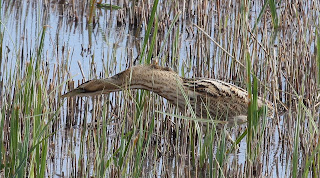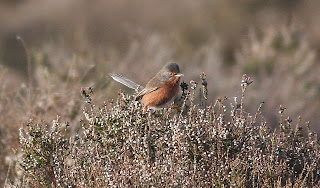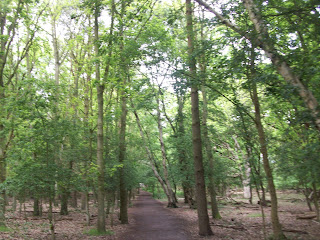Despite things having kicked off on the bird front with a singing Nightingale on the Wivenhoe Trail in Essex on the 9th, the 10th April marked the start of proper birding on my trip down to East Anglia. My friends that I was staying with in Essex planned to take us to Minsmere for the day, and for most birders Minsmere only spells one thing – good quality birding! This was only the second time I had been to Minsmere – the first time I went was in June last year where I managed to see my first Purple Heron in Britain. Having had such a brilliant time on my previous visit I was very excited to visit again, and it didn’t fail to disappoint me.
We arrived at around midday, and set off in the direction of the famous East Hide at the very east end of the reserve near the beach. A Green Woodpecker (yeartick) was seen in and around the North Bushes not very far from the visitor centre, and as the vast expanse of reedbeds that came into view for the first time a Little Egret (yeartick) flew over the path. We walked alongside the path opposite the beach until we reached the turn for East Hide, and once inside the hide I immediately became absorbed by the bird haven that is Minsmere. The fantastic thing about reserves like Minsmere is that even during times where most would deem it as ‘quiet’, there is still so much to see and the amount of common birds present is just sensational. On top of that, what East Anglian birders would class as the ‘norm’ are a delight to a lot of visiting birders. Within seconds of arriving I was on some Avocets (yeartick), a bird you just don’t get with any sort of regularity in North East Scotland at all. Whenever I see these fantastic waders I cannot help but be gob-smacked by their beauty; they truly are the embodiment of grace. What’s more, at Minsmere – and in East Anglia – they are a widespread wader. From the East Hide alone there were at least 25 and by the end of the day I had counted upwards of 40 Avocets throughout the reserve. Below are a couple of pictures I managed of these delightful waders from East Hide.

Avocets, Minsmere, 10/4/11

A lot was going on at the East Hide. In addition to the Avocets other waders were around en masse, including all the commoner suspects as well a single Ruff close to a few Turnstones on the East Scrape. Furthermore 2 Marsh Harriers (yeartick) were distantly flying up and down the reedbeds in their usual leisurely fashion, and there was a huge amount of gulls, including all of the commoner suspects. Many of the Black-headed Gulls seemed to be inspired to mate due to the lovely weather, including this pair...
Black-headed Gull, Minsmere, 10/4/11
There was also a large amount of wildfowl present from East Hide, with a majority of the commoner ducks being present. More notably there were 5 Barnacle Geese dotted around the pools and cracking views of a pair of Pintail were had no more than 60ft from the hide. Many of the commoner ducks were showing at very close quarters as well which was a treat and allowed for some ideal photographic opportunities. A drake Teal and a drake Shoveler were particularly photogenic.

Teal, Minsmere, 10/4/11
Shoveler, Minsmere, 10/4/11

We spent 45 minutes or so at East Hide, and then proceeded to meander around the rest of the reserve. We soon found ourselves encompassed reedbeds and walked all the way through these until we got to West Hide, which held the same variety of birds as East Hide but was still a pleasure to visit. Once we had visited West Hide we headed through Minsmere’s beautiful, ancient and untouched woodland which fringes the reeds towards Bittern and Island Mere Hide, the latter hide being the place where I had seen the Purple Heron the year before. During a clearing in the woodland, I spotted a fine male Wheatear (yeartick) on an area of rough ground. Bittern Hide provided a fantastic view across the reedbed but held relatively little in comparison to the East and West Hides. The only species of note here was a Cetti’s Warbler (yeartick) which was singing in the reeds right by the hide and briefly showed on top of one of the closest reeds. I had several Cetti’s Warblers exploding with song from the reedbeds prior to this, but had not managed to see one until that point. They are always a joy to hear and see as yet again they are a bird that you virtually never see in Scotland. Island Mere Hide was the final hide we would visit in Minsmere and we didn’t plan to stay long as lunch was on the cards. However, something was going to keep us there for much longer than we had planned....
At first there didn’t appear to be a great deal going on from Island Mere Hide at all, with spectacularly close views of a pair of Marsh Harriers providing the main form of entertainment for everyone. We had been sat there for 15 minutes and were just about to leave when suddenly a man sitting nearby exclaimed ‘There’s a Bittern, coming out of the reeds about 25ft away!’ Everyone in the hide turned their attention to this area of reeds and sure enough, out of the reeds emerged a Bittern (yeartick). Everyone watched in awe as it proceeded to creep low down in a cat-like fashion right out into the open, it’s snake-long neck outstretched as it took giant yet silent steps and looked around warily, as if it had realised how conspicuous it had become. Once it was fully on show I proceeded to get my camera out and photograph it determinedly. The views of this enigmatic bird were unbelievable as not only was it at close quarters, but it also stayed right out in the open for upwards of half an hour which was ridiculously good! Within that half an hour the bird got closer and closer and I took hundreds of photos of it, capturing it in many different stances including the typical camouflage stance in which it stretches its neck completely upright to try and blend in with the reeds – something they are remarkably good at doing. The astonishing show that this bird was unconsciously putting on had everyone bowled over, including me; this was by far the best view I had ever had of Bittern and certainly the most prolonged views! It took my Dad a while to convince me to leave, but eventually I gave in and headed back to the car an immensely happy guy. I hope the several pictures go to show how amazing the views of this bird were.

Bittern, Minsmere, 10/4/11







I left Minsmere longing to return – it really had shown why it is one of the best reserves in Britain for birding. A late lunch was had in the nearby village of Eastbridge, and then we headed to our final destination of the day – the nearby Dunwich Heath. My primary aim was to see Dartford Warbler, yet another one of that is somewhat a speciality species to most birders. Dunwich Heath looks right down onto Minsmere and is very interesting in that it is a coastal heath. Once parked up at the car park, my Dad and I left our friends to go down to the beach and we headed off into the expansive heathland with about half an hour to spare before we had to head home. As I headed along the main path my attention was drawn to a very small bird perched on top a piece of heather – a male Stonechat (yeartick). A scattering of Linnets were around too, but this seemed to be the extent as we headed back towards the road realising that time was becoming short. We were by an area of gorse and on the verge of calling it a day when I suddenly heard a coarse, single-note coming from the heather nearby, a definite Sylvia warbler – and the only Sylvia warbler it could possibly be was a Dartford Warbler. I slowly made my way off the path and tried to flush it. I went some way but nothing seemed to come of my tactics. I moved a little bit further, and finally I flushed it. It proceeded to land right on the top of a piece of short heather and confirmed itself to be a male Dartford Warbler, its vinous red breast glinting in the sun. My Dad soon joined me and we enjoyed very good views of this Dartford Warbler as it flitted around and perched itself conspicuously on several pieces of gorse. At its closest it was no more than 35ft, so I managed several photos. We watched it for 5 minutes so and then had to head off, but I left very pleased having seen my target bird and obtained fantastic views of a bird I would never see at home.

Dartford Warbler, Dunwich, Heath, 10/4/11
The day ended on that note, a day which had consisted of unforgettable views of Bittern, great views of Dartford Warbler, several Avocets, Cetti’s Warbler and many other good birds. It had been an excellent day, and with the first of three birding days on the Suffolk and Norfolk coast coming up the next day the good birding would not stop. Stay tuned to read about my first day of birding in Norfolk/Suffolk. I will leave you with pictures of Minsmere. For larger images of the photos in this post please check out my flickr, linked below.
View of Minsmere (1)
Minsmere (2)
Minsmere woodland (taken on 2010 visit)
Dunwich Heath
Thanks for reading,
Joseph




 The area of bushes to the left of this picture was where it was singing....
The area of bushes to the left of this picture was where it was singing....